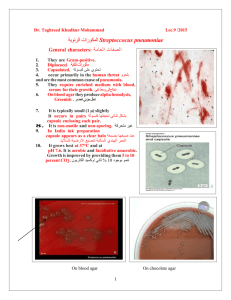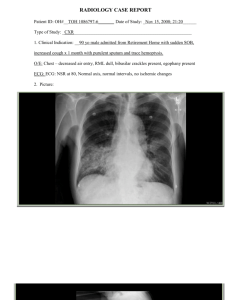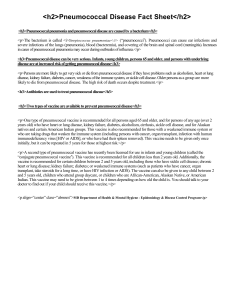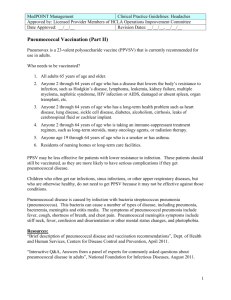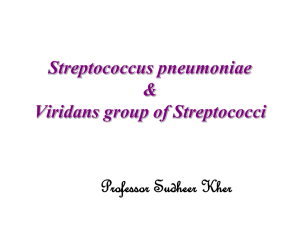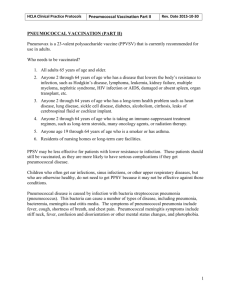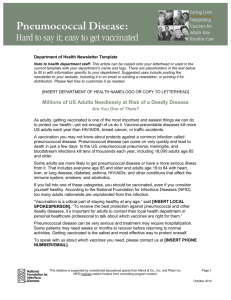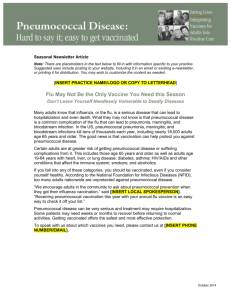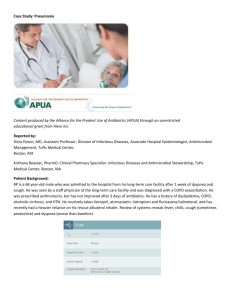أعلى النموذج (5)Streptococcus pneumoniae The pneumococci (S
advertisement
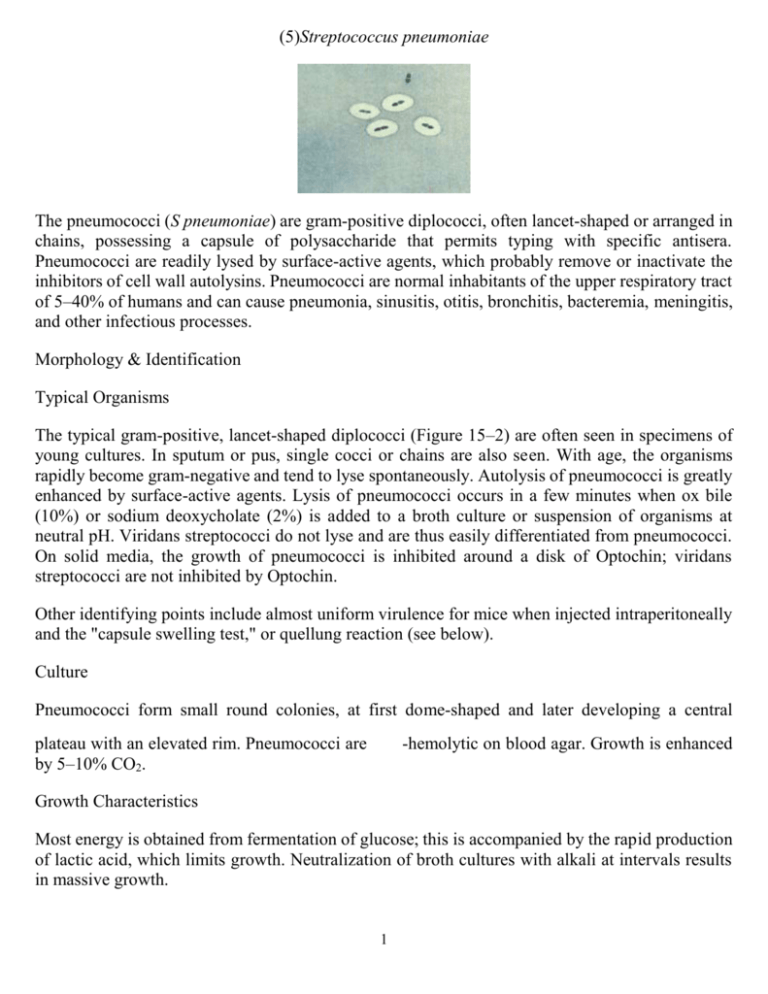
(5)Streptococcus pneumoniae The pneumococci (S pneumoniae) are gram-positive diplococci, often lancet-shaped or arranged in chains, possessing a capsule of polysaccharide that permits typing with specific antisera. Pneumococci are readily lysed by surface-active agents, which probably remove or inactivate the inhibitors of cell wall autolysins. Pneumococci are normal inhabitants of the upper respiratory tract of 5–40% of humans and can cause pneumonia, sinusitis, otitis, bronchitis, bacteremia, meningitis, and other infectious processes. Morphology & Identification Typical Organisms The typical gram-positive, lancet-shaped diplococci (Figure 15–2) are often seen in specimens of young cultures. In sputum or pus, single cocci or chains are also seen. With age, the organisms rapidly become gram-negative and tend to lyse spontaneously. Autolysis of pneumococci is greatly enhanced by surface-active agents. Lysis of pneumococci occurs in a few minutes when ox bile (10%) or sodium deoxycholate (2%) is added to a broth culture or suspension of organisms at neutral pH. Viridans streptococci do not lyse and are thus easily differentiated from pneumococci. On solid media, the growth of pneumococci is inhibited around a disk of Optochin; viridans streptococci are not inhibited by Optochin. Other identifying points include almost uniform virulence for mice when injected intraperitoneally and the "capsule swelling test," or quellung reaction (see below). Culture Pneumococci form small round colonies, at first dome-shaped and later developing a central plateau with an elevated rim. Pneumococci are by 5–10% CO2. -hemolytic on blood agar. Growth is enhanced Growth Characteristics Most energy is obtained from fermentation of glucose; this is accompanied by the rapid production of lactic acid, which limits growth. Neutralization of broth cultures with alkali at intervals results in massive growth. 1 Variation Pneumococcal isolates that produce large amounts of capsules produce large mucoid colonies. Capsule production is not essential for growth on agar medium, and capsular production is, therefore, lost after a small number of subcultures. The pneumococci will, however, again produce capsules and have enhanced virulence if injected into mice. Antigenic Structure Component Structures The pneumococcal cell wall has peptidoglycan and teichoic acid, like other streptococci. The capsular polysaccharide is covalently bound to the peptidoglycan and to the cell wall polysaccharide. The capsular polysaccharide is immunologically distinct for each of the more than 90 types. Quellung Reaction When pneumococci of a certain type are mixed with specific antipolysaccharide serum of the same type—or with polyvalent antiserum—on a microscope slide, the capsule swells markedly, and the organisms agglutinate by cross-linking of the antibodies. This reaction is useful for rapid identification and for typing of the organisms, either in sputum or in cultures. The polyvalent antiserum, which contains antibody to all of the types ("omniserum"), is a good reagent for rapid microscopic determination of whether or not pneumococci are present in fresh sputum. Pathogenesis Types of Pneumococci In adults, types 1–8 are responsible for about 75% of cases of pneumococcal pneumonia and for more than half of all fatalities in pneumococcal bacteremia; in children, types 6, 14, 19, and 23 are frequent causes. Production of Disease Pneumococci produce disease through their ability to multiply in the tissues. They produce no toxins of significance. The virulence of the organism is a function of its capsule, which prevents or delays ingestion by phagocytes. A serum that contains antibodies against the type-specific polysaccharide protects against infection. If such a serum is absorbed with the type-specific polysaccharide, it loses its protective power. Animals or humans immunized with a given type of pneumococcal polysaccharide are subsequently immune to that type of pneumococcus and possess precipitating and opsonizing antibodies for that type of polysaccharide. Loss of Natural Resistance Since 40–70% of humans are at some time carriers of virulent pneumococci, the normal 2 respiratory mucosa must possess great natural resistance to the pneumococcus. Among the factors that probably lower this resistance and thus predispose to pneumococcal infection are the following: (1) Viral and other respiratory tract infections that damage surface cells; abnormal accumulations of mucus (eg, allergy), which protect pneumococci from phagocytosis; bronchial obstruction (eg, atelectasis); and respiratory tract injury due to irritants disturbing its mucociliary function. (2) Alcohol or drug intoxication, which depresses phagocytic activity, depresses the cough reflex, and facilitates aspiration of foreign material. (3) Abnormal circulatory dynamics (eg, pulmonary congestion, heart failure). (4) Other mechanisms, eg, malnutrition, general debility, sickle cell anemia, hyposplenism, nephrosis, or complement deficiency. Pathology Pneumococcal infection causes an outpouring of fibrinous edema fluid into the alveoli, followed by red cells and leukocytes, which results in consolidation of portions of the lung. Many pneumococci are found throughout this exudate, and they may reach the bloodstream via the lymphatic drainage of the lungs. The alveolar walls remain normally intact during the infection. Later, mononuclear cells actively phagocytose the debris, and this liquid phase is gradually reabsorbed. The pneumococci are taken up by phagocytes and digested intracellularly. Clinical Findings The onset of pneumococcal pneumonia is usually sudden, with fever, chills, and sharp pleural pain. The sputum is similar to the alveolar exudate, being characteristically bloody or rusty colored. Early in the disease, when the fever is high, bacteremia is present in 10–20% of cases. With antimicrobial therapy, the illness is usually terminated promptly; if drugs are given early, the development of consolidation is interrupted. Pneumococcal pneumonia must be differentiated from pulmonary infarction, atelectasis, neoplasm, congestive heart failure, and pneumonia caused by many other bacteria. Empyema (pus in the pleural space) is a significant complication and requires aspiration and drainage. From the respiratory tract, pneumococci may reach other sites. The sinuses and middle ear are most frequently involved. Infection sometimes extends from the mastoid to the meninges. Bacteremia from pneumonia has a triad of severe complications: meningitis, endocarditis, and septic arthritis. With the early use of chemotherapy, acute pneumococcal endocarditis and arthritis have become rare. 3 Diagnostic Laboratory Tests Blood is drawn for culture; CSF and sputum are collected for demonstration of pneumococci by smear and culture. Serum antibody tests are impractical. Sputum may be examined in several ways. Stained Smears A Gram-stained film of rusty-red sputum shows typical organisms, many polymorphonuclear neutrophils, and many red cells. Capsule Swelling Tests Fresh emulsified sputum mixed with antiserum causes capsule swelling (the quellung reaction) for identification of pneumococci. Culture The culture is created by sputum cultured on blood agar and incubated in CO 2 or a candle jar. A blood culture is also taken. Treatment Since pneumococci are sensitive to many antimicrobial drugs, early treatment usually results in rapid recovery, and antibody response seems to play a much diminished role. Penicillin G is the drug of choice, but in the United States 5–10% of pneumococci are penicillin-resistant (MIC g/mL) and about 20% are moderately resistant (MIC 0.1–1 2 g/mL). High-dose penicillin G with MICs of 0.1–2 g/mL appears to be effective in treating pneumonia caused by pneumococci but would not be effective in treatment of meningitis due to the same strains. Some penicillin-resistant strains are resistant to cefotaxime. Resistance to tetracycline and erythromycin occurs also. Pneumococci remain susceptible to vancomycin. Epidemiology, Prevention, & Control Pneumococcal pneumonia accounts for about 60% of all bacterial pneumonias. In the development of illness, predisposing factors (see above) are more important than exposure to the infectious agent, and the healthy carrier is more important in disseminating pneumococci than the sick patient. It is possible to immunize individuals with type-specific polysaccharides. Such vaccines can probably provide 90% protection against bacteremic pneumonia. A polysaccharide vaccine containing 23 types is licensed in the United States. This vaccine is appropriate for elderly, debilitated, or immunosuppressed individuals. A pneumococcal conjugate vaccine contains 4 capsular polysaccharides conjugated to diphtheria CRM 197 protein. This seven-valent vaccine is recommended for all children aged 2–23 months, to help prevent ear infections, and for selected children aged 24–59 months. 5
